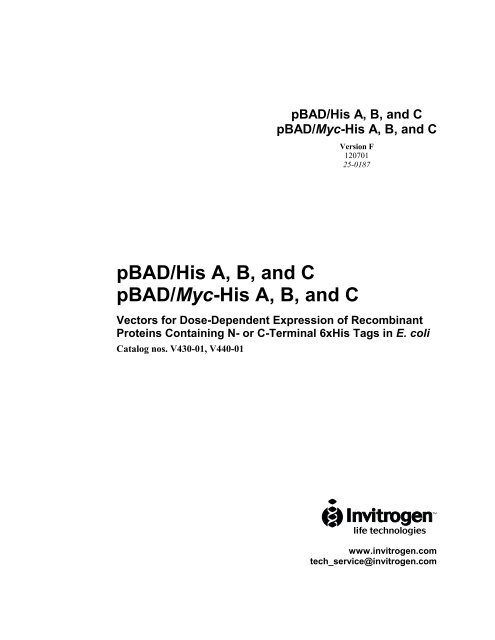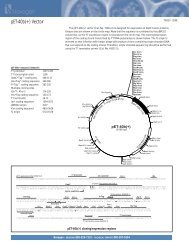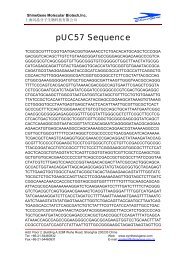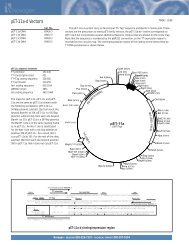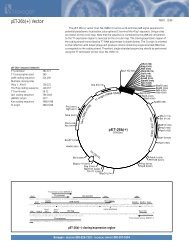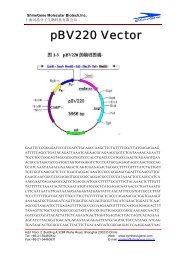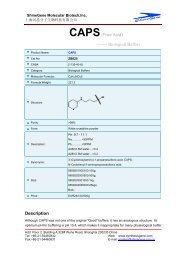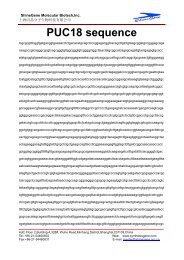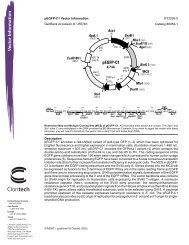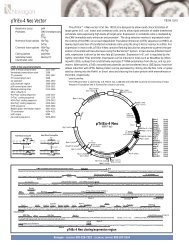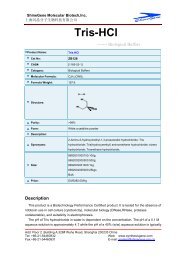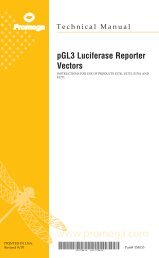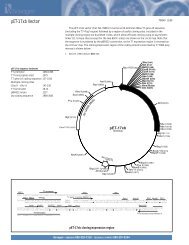pBAD/Myc - Gene Synthesis
pBAD/Myc - Gene Synthesis
pBAD/Myc - Gene Synthesis
Create successful ePaper yourself
Turn your PDF publications into a flip-book with our unique Google optimized e-Paper software.
Table of ContentsTable of Contents................................................................................................................................................iiiImportant Information......................................................................................................................................... ivIntroduction.................................................................................................................. 1Overview.............................................................................................................................................................. 1<strong>pBAD</strong>/His Vector ................................................................................................................................................ 3<strong>pBAD</strong>/<strong>Myc</strong>-His Vector ........................................................................................................................................ 5Methods........................................................................................................................ 7<strong>Gene</strong>ral Cloning................................................................................................................................................... 7Cloning into <strong>pBAD</strong>/His ....................................................................................................................................... 8Cloning into <strong>pBAD</strong>/<strong>Myc</strong>-His ............................................................................................................................. 12E. coli Transformation ....................................................................................................................................... 16Expression.......................................................................................................................................................... 17Purification......................................................................................................................................................... 21Appendix .................................................................................................................... 22<strong>pBAD</strong>/His/lacZ.................................................................................................................................................. 22<strong>pBAD</strong>/<strong>Myc</strong>-His/lacZ.......................................................................................................................................... 23Recipes............................................................................................................................................................... 24Technical Service............................................................................................................................................... 27References.......................................................................................................................................................... 30iii
Important InformationContentsThis manual is provided with the following kits:Catalog No.ContentsV430-01 20 µg each <strong>pBAD</strong>/His A, B, and C, lyophilized20 µg <strong>pBAD</strong>/His/lacZ, lyophilized1 ml sterile, 20% L-arabinose1 stab LMG1941 stab TOP10V440-01 20 µg each <strong>pBAD</strong>/<strong>Myc</strong>-His A, B, and C, lyophilized20 µg <strong>pBAD</strong>/<strong>Myc</strong>-His/lacZ, lyophilized1 ml sterile, 20% L-arabinose1 stab LMG1941 stab TOP10Shipping/Storage Kits are shipped at room temperature. Upon receipt, store the plasmids and the 20%L-arabinose solution at -20°C. Stabs should be stored at room temperature.PurchaserNotificationaraB promoterProducts containing the araB promoter are sold under patent license for researchpurposes only and are non-transferable. Inquiries for any commercial use, includingproduction of material to be sold commercially or used in production or in productdevelopment efforts which includes efforts toward regulatory approval, should be madedirectly to Xoma Corporation, Berkeley, California.Xoma Corporation2910 Seventh StreetBerkeley, CA 94710Tel: 1-510-644-1170Fax: 1-510-649-7571Polyhistidine (6xHis) TagThis product is licensed under U.S. Patents 5,284,933 and 5,310,663 and foreignequivalents from Hoffmann-LaRoche, Inc., Nutley, NJ and/or Hoffmann-LaRoche Ltd.,Basel, Switzerland and is provided only for use in research. Information about licenses forcommercial use is available from:QIAGEN GmbHMax-Volmer-Str. 4D-40724 Hilden, Germanyiv
IntroductionOverviewIntroductionThe <strong>pBAD</strong>/His and <strong>pBAD</strong>/<strong>Myc</strong>-His plasmids are pBR322-derived expression vectorsdesigned for regulated, dose-dependent recombinant protein expression and purificationin E. coli. Optimum levels of soluble, recombinant protein are possible using the araBADpromoter (P BAD) from E. coli. The regulatory protein, AraC, is provided on the <strong>pBAD</strong>/Hisand <strong>pBAD</strong>/<strong>Myc</strong>-His vectors allowing regulation of P BAD.Regulation ofExpression byL-arabinoseIn the presence of L-arabinose, expression from P BAD is turned on while the absence ofL-arabinose produces very low levels of transcription from P BAD (Lee, 1980; Lee et al.,1987). Uninduced levels are repressed even further by growth in the presence of glucose.Glucose reduces the levels of 3´,5´-cyclic AMP, thus lowering expression of thecatabolite-repressed P BAD promoter (Miyada et al., 1984). By varying the concentrationof L-arabinose, protein expression levels can be optimized to ensure maximum expressionof soluble protein. In addition, the tight regulation of P BAD by AraC is useful forexpression of potentially toxic or essential genes (Carson et al., 1991; Dalbey andWickner, 1985; Guzman et al., 1992; Kuhn and Wickner, 1985; Russell et al., 1989; SanMillan et al., 1989). For more information on the mechanism of expression and repressionof the ara regulon, please refer to Schleif, 1992.ExperimentalOutlineThe table below describes the basic steps needed to clone and express your protein using<strong>pBAD</strong>/His or <strong>pBAD</strong>/<strong>Myc</strong>-His. For more details, please refer to the page(s) indicated.Step Action Page1 Develop a cloning strategy to ligate your gene of interest into the desiredvector. Please refer to the appropriate pages for the multiple cloning sitesof each version of the vector:<strong>pBAD</strong>/His A, B, and C 8-11<strong>pBAD</strong>/<strong>Myc</strong>-His A, B, and C 12-152 To propagate and maintain the empty vectors and recombinantconstructs, transform them into a recA, endA E. coli host (i.e. TOP10).73 Ligate your gene of interest into <strong>pBAD</strong>/His or <strong>pBAD</strong>/<strong>Myc</strong>-His, transforminto TOP10 or LMG194, and select on 50-100 µg/ml ampicillin.4 Sequence your construct to ensure that it is in frame with the N-terminal(<strong>pBAD</strong>/His) or C-terminal (<strong>pBAD</strong>/<strong>Myc</strong>-His) peptide.5 Perform a 4-hour expression using a 10,000-fold range of L-arabinoseconcentrations (e.g. 0.00002%, 0.0002%, 0.002%, 0.02%, and 0.2%).Use appropriate controls. Vectors expressing β-galactosidase areavailable with each kit. Antibodies are available for detection ofrecombinant proteins (see next page).6 Optimize expression by varying L-arabinose concentration or the time ofinduction.7 Purify your recombinant protein by chromatography on metal-chelatingresin (e.g. ProBond ).716161819-2021continued on next page1
Overview, continuedDetection ofRecombinantProteinsExpression of your recombinant protein can be detected using an antibody to theappropriate epitope. The table below describes the antibodies available for use with<strong>pBAD</strong>/His or <strong>pBAD</strong>/<strong>Myc</strong>-His. Horseradish peroxidase (HRP)-conjugated antibodiesallow one-step detection using colorimetric or chemiluminescent detection methods.Vector Epitope Antibody Catalog No.<strong>pBAD</strong>/His Anti-Xpress Anti-Xpress R910-25<strong>pBAD</strong>/<strong>Myc</strong>-His c-myc Anti-<strong>Myc</strong> R950-25C-terminalpolyhistidine tagAnti-<strong>Myc</strong>-HRP R951-25Anti-His(C-term) R930-25Anti-His(C-term)-HRP R931-25Purification ofRecombinantProteinThe metal binding domain encoded by the polyhistidine tag allows simple, easypurification of your recombinant protein by Immobilized Metal Affinity Chromatography(IMAC) using Invitrogen's ProBond Resin (see below). To purify proteins expressedusing <strong>pBAD</strong>/His or <strong>pBAD</strong>/<strong>Myc</strong>-His, the ProBond Purification System or the ProBond resin in bulk are available separately. See the table below for ordering information.Product Quantity Catalog no.ProBond Purification System 6 purifications K850-01ProBond Metal-Binding Resin(precharged resin provided as a 50% slurry in 20%ethanol)Purification Columns(10 ml polypropylene columns)50 ml R801-01150 ml R801-1550 R640-502
<strong>pBAD</strong>/His VectorFeatures of<strong>pBAD</strong>/HisThe important elements of <strong>pBAD</strong>/His A (4102bp), <strong>pBAD</strong>/His B (4092 bp), and<strong>pBAD</strong>/His C (4100 bp) are described in the following table. All features have beenfunctionally tested.FeaturearaBAD promoter (P BAD)Optimized ribosome binding siteInitiation ATGN-terminal polyhistidine tagAnti-Xpress epitope(Asp-Leu-Tyr-Asp-Asp-Asp-Asp-Lys)Enterokinase cleavage site(Asp-Asp-Asp-Asp-Lys)Multiple cloning siterrnB transcription termination regionAmpicillin resistance gene (β-lactamase)pBR322 originaraC geneBenefitProvides tight, dose-dependent regulation ofheterologous gene expression (Guzman etal., 1995)Increases efficiency of recombinant fusionprotein expressionProvides a translational initiation site for thefusion proteinForms metal-binding site for affinitypurification of recombinant fusion proteinon metal-chelating resin (i.e. ProBond )Permits detection of recombinant fusionprotein by the Anti-Xpress Antibody(Catalog no. R910-25)Allows removal of the N-terminal peptideby enterokinase (i.e. EKMax , Catalog no.E180-01) for production of native proteinAllows insertion of your gene for expressionStrong transcription termination regionAllows selection of the plasmid in E. coliLow copy replication and growth in E. coliEncodes the regulatory protein for tightregulation of the P BAD promoter (Lee, 1980;Schleif, 1992)continued on next page3
<strong>pBAD</strong>/His Vectors, continuedMap of <strong>pBAD</strong>/HisThe figure below summarizes the features of the <strong>pBAD</strong>/His vector. Complete sequencesfor all three <strong>pBAD</strong>/His vectors are available for downloading from our World Wide Website (www.invitrogen.com) or by contacting Technical Service (see page 27). Details ofeach multiple cloning site are shown on pages 9-11.Xho ISac I*Bgl IIPst IPvu II*Kpn IEcoR ISfu IHind IIIPBADATG6xHis Xpress EKEpitope SiteMCS termaraC<strong>pBAD</strong>/HisA,B,C4.1 kbAmpicillinComments for <strong>pBAD</strong>/His A4102 nucleotidespBR322 oriaraBAD promoter region: bases 4-276Initiation ATG: bases 319-321Polyhistidine tag: bases 331-348Xpress epitope: bases 388-411Enterokinase recognition site: bases 397-411Multiple cloning site: bases 430-470rrnB transcription termination region: bases 553-710Ampicillin ORF: bases 989-1849pBR322 origin: bases 1994-2667AraC ORF: bases 4076-3198* Sac I and Pvu II are notpresent in version C.4
<strong>pBAD</strong>/<strong>Myc</strong>-His VectorFeatures of<strong>pBAD</strong>/<strong>Myc</strong>-HisThe important elements of <strong>pBAD</strong>/<strong>Myc</strong>-His A (4094 bp), <strong>pBAD</strong>/<strong>Myc</strong>-His B (4092 bp),and <strong>pBAD</strong>/<strong>Myc</strong>-His C (4093 bp) are described in the following table. All features havebeen functionally tested.FeaturearaBAD promoter (P BAD)Optimized ribosome binding siteInitiation ATGMultiple cloning siteC-terminal myc epitope tag(Glu-Gln-Lys-Leu-Ile-Ser-Glu-Glu-Asp-Leu)C-terminal polyhistidine regionrrnB transcription termination regionBenefitProvides tight, dose-dependent regulation ofheterologous gene expression (Guzman etal., 1995)Increases efficiency of recombinant fusionprotein expressionProvides a translational initiation site for thefusion proteinAllows insertion of your gene for expressionAllows detection of the fusion protein by theAnti-<strong>Myc</strong> Antibody (Catalog no. R950-25)(Evans et al., 1985)Forms metal-binding site for affinitypurification of recombinant fusion proteinon metal-chelating resin (i.e. ProBond )In addition, it allows detection of therecombinant protein with Anti-His (C-term)Antibody (see page 2)Strong transcription termination regionAmpicillin resistance gene (β-lactamase) Allows selection of the plasmid in E. colipBR322 originaraC geneLow copy replication and growth in E. coliEncodes the regulatory protein for tightregulation of the P BAD promoter (Lee, 1980;Schleif, 1992)continued on next page5
<strong>pBAD</strong>/<strong>Myc</strong>-His Vectors, continuedMap of<strong>pBAD</strong>/<strong>Myc</strong>-HisThe figure below summarizes the features of the <strong>pBAD</strong>/<strong>Myc</strong>-His vector. Completesequences for all three <strong>pBAD</strong>/<strong>Myc</strong>-His vectors are available for downloading from ourWorld Wide Web site (www.invitrogen.com) or by contacting Technical Service (seepage 27). Details of each multiple cloning site are shown on pages 13-15.Nco IXho ISac IBgl IIPst IPvu IIKpn IEcoR ISfu IHind IIISnaB I*Xba I*PBAD ATG MCS myc 6xHistermaraC<strong>pBAD</strong>/<strong>Myc</strong>-HisA,B,C4.1 kbAmpicillinComments for <strong>pBAD</strong>/<strong>Myc</strong>-His A,4094 nucleotidespBR322 oriaraBAD promoter region: bases 4-276Initiation ATG: bases 319-321Multiple cloning site: bases 317-370myc epitope: bases 377-406Polyhistidine tag: bases 422-439rrnB transcription termination region: bases 545-702Ampicillin ORF: bases 981-1841pBR322 origin: bases 1986-2659AraC ORF: bases 4068-3190* Version A does not containSnaB I or Xba I.Version B contains Xba I only.Version C contains SnaB I only.6
Methods<strong>Gene</strong>ral CloningIntroductionThe following information is provided to help you clone your gene of interest into<strong>pBAD</strong>/His or <strong>pBAD</strong>/<strong>Myc</strong>-His. For basic information on DNA ligations, E. colitransformations, restriction enzyme analysis, DNA sequencing, and DNA biochemistry,please see Molecular Cloning: A Laboratory Manual (Sambrook et al., 1989) or CurrentProtocols in Molecular Biology (Ausubel et al., 1994).E. coli Host For cloning and transformation, we recommend using a recA, endA strain such as TOP10(included in the kit). This strain is capable of transporting L-arabinose, but not metabolizingit. This is important for expression studies as the level of L-arabinose will be constant insidethe cell and not decrease over time. Please note that other strains may be suitable for generaluse. Be sure to check the genotype of your strain. It should be araBADC - and araEFGH +(Bachmann, 1990).The E. coli strain LMG194 is included in the kit to ensure low basal level expression oftoxic genes (Guzman et al., 1995). This strain is capable of growth on minimal medium(RM medium), which allows additional repression of P BAD by glucose. Once you havedetermined that you have the correct construct, transform it into LMG194 prior toperforming expression experiments.For your convenience, TOP10 is available as electrocompetent or chemically competentcells in a One Shot ® kit format.Item Quantity Catalog no.Electrocomp TOP10 5 x 80 µl C664-5510 x 80 µl C664-1130 x 80 µl C664-24One Shot ® TOP10 Competent Cells 21 x 50 µl C4040-03Genotype ofTOP10F- mcrA ∆(mrr-hsdRMS-mcrBC) φ80lacZ∆M15 ∆lacX74 deoR recA1 araD139 ∆(araAleu)7697galU galK rpsL endA1 nupG. Note: This strain is araBADC - . It is deleted forboth araBA and araC, and the gene for araD has a point mutation in it, making it inactive.Genotype ofLMG194F- ∆lacX74 gal E thi rpsL ∆phoA (Pvu II) ∆ara714 leu::Tn10. Please note that this strainis streptomycin and tetracycline resistant.Maintenance of<strong>pBAD</strong>/His and<strong>pBAD</strong>/<strong>Myc</strong>-HisTo propagate and maintain <strong>pBAD</strong>/His or <strong>pBAD</strong>/<strong>Myc</strong>-His, we recommend that youresuspend the lyophilized vector in 20 µl sterile water to make a 1 µg/µl stock solution.Store the stock solution at -20°C.Use this stock solution to transform a recA, endA E. coli strain like DH5α, TOP10 orequivalent. Transformants are selected on LB plates containing 50-100 µg/ml ampicillin.Note: Use strains like DH5α only for propagation of <strong>pBAD</strong>/His or <strong>pBAD</strong>/<strong>Myc</strong>-His, butnot expression of recombinant proteins (see explanation above). Be sure to prepare aglycerol stock of each plasmid for long-term storage (see page 16).7
Cloning into <strong>pBAD</strong>/HisImportantTo generate recombinant proteins that are expressed correctly and contain the N-terminalfusion peptide, it is necessary to clone in frame with the N-terminal peptide. To facilitatecloning, the <strong>pBAD</strong>/His vector is provided in three different reading frames. They differonly in the spacing between the sequences that code for the N-terminal peptide and themultiple cloning site. For proper expression, first determine which restriction sites areappropriate for ligation and then which vector will preserve the reading frame at the 5´end. Be sure to include a stop codon to terminate translation of your protein.<strong>pBAD</strong>/HisMultiple CloningSitesThe multiple cloning sites of each version of <strong>pBAD</strong>/His are provided on pages 9-11.Restriction sites are labeled to indicate cleavage site. The boxed sequence is the variableregion that facilitates in frame cloning with the N-terminal peptide. This variable region islocated between the enterokinase cleavage site and the Xho I site.Features of the araBAD and araC promoters are marked and described as follows. Formore information please see Lee, 1980; Miyada, et al., 1984; Lee, et al., 1987; andSchleif, 1992.• O 2 region: Binding site of AraC that represses transcription from P BAD.• O 1 region: Binding site of AraC that represses transcription of the araC promoter (P C)(transcribed on the opposite strand; not shown).• CAP binding site: Site where CAP (cAMP binding protein) binds to help activatetranscription from P BAD and P C.• I 2 and I 1 regions: Binding sites of AraC that activate transcription from P BAD.• -10 and -35 regions: Binding sites of RNA polymerase for transcription of P BAD.Each multiple cloning site has been confirmed by sequencing and functional testing.continued on next page8
Cloning into <strong>pBAD</strong>/His, continued<strong>pBAD</strong>/His AMultiple Cloning Site1O 2 RegionAAGAAACCAA TTGTCCATAT TGCATCAGAC ATTGCCGTCA CTGCGTCTTT TACTGGCTCT61121181241301358412466TCTCGCTAAC CAAACCGGTA ACCCCGCTTA TTAAAAGCAT TCTGTAACAA AGCGGGACCAO 1 RegionAAGCCATGAC AAAAACGCGT AACAAAAGTG TCTATAATCA CGGCAGAAAA GTCCACATTGCAP binding siteATTATTTGCA CGGCGTCACA CTTTGCTATG CCATAGCATT TTTATCCATA AGATTAGCGGI 2 and I 1 Region-35 -10ATCCTACCTG ACGCTTTTTA TCGCAACTCT CTACTGTTTC TCCATACCCG TTTTTTGGGCRBSNco IPolyhistidine RegionTAACAGGAGG AATTAACC ATG GGG GGT TCT CAT CAT CAT CAT CAT CAT GGT ATG GCTMet Gly Gly Ser His His His His His His Gly Met AlaXpress EK recognition siteEpitopeAGC ATG ACT GGT GGA CAG CAA ATG GGT CGG GAT CTG TAC GAC GAT GAC GAT AAGSer Met Thr Gly Gly Gln Gln Met Gly Arg Asp Leu Tyr Asp Asp Asp Asp LysEK cleavage siteXho I Sac I Bgl II Pst I Pvu II Kpn I EcoR I Sfu IGAT CGA TGG GGA TCC GAG CTC GAG ATC TGC AGC TGG TAC CAT ATG GGA ATT CGAAsp Arg Trp Gly Ser Glu Leu Glu Ile Cys Ser Trp Tyr His Met Gly Ile ArgHind IIIAGC TTG GCTGTTTTG GCGGATGAGA GAAGATTTTC AGCCTGATAC AGATTAAATC AGAACGCAGASer Leu531591AGCGGTCTGA TAAAACAGAA TTTGCCTGGC GGCAGTAGCG CGGTGGTCCC ACCTGACCCCrrnB T1 and T2 transcriptional terminatorATGCCGAACT CAGAAGTGAA ACGCCGTAGC GCCGATGGTA GTGTGGGGTC TCCCCATGCG651AGAGTAGGGA ACTGCCAGGC ATCAAATAAA ACGAAAGGCT CAGTCGAAAG ACTGGGCCTT711TCGTTTTATcontinued on next page9
Cloning into <strong>pBAD</strong>/His, continued<strong>pBAD</strong>/His BMultiple Cloning Site1O 2 RegionAAGAAACCAA TTGTCCATAT TGCATCAGAC ATTGCCGTCA CTGCGTCTTT TACTGGCTCT61121181241301358412TCTCGCTAAC CAAACCGGTA ACCCCGCTTA TTAAAAGCAT TCTGTAACAA AGCGGGACCAO 1 RegionAAGCCATGAC AAAAACGCGT AACAAAAGTG TCTATAATCA CGGCAGAAAA GTCCACATTGCAP binding siteATTATTTGCA CGGCGTCACA CTTTGCTATG CCATAGCATT TTTATCCATA AGATTAGCGGI 2 and I 1 Region-35 -10ATCCTACCTG ACGCTTTTTA TCGCAACTCT CTACTGTTTC TCCATACCCG TTTTTTGGGCRBSNco IPolyhistidine RegionTAACAGGAGG AATTAACC ATG GGG GGT TCT CAT CAT CAT CAT CAT CAT GGT ATG GCTMet Gly Gly Ser His His His His His His Gly Met AlaXpress EK recognition siteEpitopeAGC ATG ACT GGT GGA CAG CAA ATG GGT CGG GAT CTG TAC GAC GAT GAC GAT AAGSer Met Thr Gly Gly Gln Gln Met Gly Arg Asp Leu Tyr Asp Asp Asp Asp LysEK cleavage siteXho I Sac I Bgl II Pst I Pvu II Kpn IEcoR ISfu I Hind IIIGAT CCG AGC TCG AGA TCT GCA GCT GGT ACC ATA TGG GAA TTC GAA GCT TGGAsp Pro Ser Ser Arg Ser Ala Ala Gly Thr Ile Trp Glu Phe Glu Ala Trp463CTGTTTTG GCGGATGAGA GAAGATTTTC AGCCTGATAC AGATTAAATC AGAACGCAGA521AGCGGTCTGA TAAAACAGAA TTTGCCTGGC GGCAGTAGCG CGGTGGTCCC ACCTGACCCC581rrnB T1 and T2 transcriptional terminatorATGCCGAACT CAGAAGTGAA ACGCCGTAGC GCCGATGGTA GTGTGGGGTC TCCCCATGCG641AGAGTAGGGA ACTGCCAGGC ATCAAATAAA ACGAAAGGCT CAGTCGAAAG ACTGGGCCTT701TCGTTTTATC TGTTGTTTG10
Cloning into <strong>pBAD</strong>/His, continued<strong>pBAD</strong>/His CMultiple Cloning Site1O2 RegionAAGAAACCAA TTGTCCATAT TGCATCAGAC ATTGCCGTCA CTGCGTCTTT TACTGGCTCT61121181241301358412460TCTCGCTAAC CAAACCGGTA ACCCCGCTTA TTAAAAGCAT TCTGTAACAA AGCGGGACCAO1 RegionAAGCCATGAC AAAAACGCGT AACAAAAGTG TCTATAATCA CGGCAGAAAA GTCCACATTGCAP binding siteATTATTTGCA CGGCGTCACA CTTTGCTATG CCATAGCATT TTTATCCATA AGATTAGCGGI 2 and I 1 Region-35 -10ATCCTACCTG ACGCTTTTTA TCGCAACTCT CTACTGTTTC TCCATACCCG TTTTTTGGGCRBSNco IPolyhistidine RegionTAACAGGAGG AATTAACC ATG GGG GGT TCT CAT CAT CAT CAT CAT CAT GGT ATG GCTMet Gly Gly Ser His His His His His His Gly Met AlaXpress EK recognition siteEpitopeAGC ATG ACT GGT GGA CAG CAA ATG GGT CGG GAT CTG TAC GAC GAT GAC GAT AAGSer Met Thr Gly Gly Gln Gln Met Gly Arg Asp Leu Tyr Asp Asp Asp Asp LysEK cleavage siteXho I Bgl II Pst I Kpn I EcoR IGAT CGA TGG ATC CGA CCT CGA GAT CTG CAG ATG GTA CCA TAT GGG AATAsp Arg Trp Ile Arg Pro Arg Asp Leu Gln Met Val Pro Tyr Gly AsnSfu I Hind IIITCG AAG CTT GGCTGTTTTG GCGGATGAGA GAAGATTTTC AGCCTGATAC AGATTAAATCSer Lys Leu519AGAACGCAGA AGCGGTCTGA TAAAACAGAA TTTGCCTGGC GGCAGTAGCG CGGTGGTCCC579rrnB T 1 and T 2 transcriptional terminatorACCTGACCCC ATGCCGAACT CAGAAGTGAA ACGCCGTAGC GCCGATGGTA GTGTGGGGTC639TCCCCATGCG AGAGTAGGGA ACTGCCAGGC ATCAAATAAA ACGAAAGGCT CAGTCGAAAG699ACTGGGCCTT TCGTTTTATCT11
Cloning into <strong>pBAD</strong>/<strong>Myc</strong>-HisImportantTo generate recombinant proteins that are expressed correctly and contain the C-terminalfusion peptide, it is necessary to clone in frame with BOTH the initiation ATG (bp 320-322) and the C-terminal peptide. The initiation ATG is correctly spaced from theoptimized RBS to ensure optimum translation.To facilitate cloning, the <strong>pBAD</strong>/<strong>Myc</strong>-His vector is provided in three different readingframes. They differ only in the spacing between the sequences that code for the multiplecloning site and the C-terminal peptide. For proper expression, first determine whichrestriction sites are appropriate for ligation and then which vector will preserve thereading frame at BOTH the 5´ and the 3´ ends. You may have to use PCR to create afragment with the appropriate restriction sites to clone in frame at both ends. Be sure thatthere is no stop codon in the open reading frame of your gene (except as noted below).If you wish to express your protein WITHOUT the C-terminal peptide, be sure toinclude a stop codon at the end of your protein.<strong>pBAD</strong>/<strong>Myc</strong>-HisMultiple CloningSiteThe multiple cloning sites of each version of <strong>pBAD</strong>/<strong>Myc</strong>-His are provided on pages 13-15. Restriction sites are labeled to indicate cleavage site. The boxed sequence is thevariable region that facilitates in frame cloning with the ATG codon and C-terminalpeptide. This variable region is located between the multiple cloning site and themyc epitope.Features of the araBAD and araC promoters are marked and described as follows. Formore information please see Lee, 1980; Miyada, et al., 1984; Lee, et al., 1987; andSchleif, 1992.• O 2 region: Binding site of AraC that represses transcription from P BAD.• O 1 region: Binding site of AraC that represses transcription of the araC promoter (P C)(transcribed on the opposite strand; not shown).• CAP binding site: Site where CAP (cAMP binding protein) binds to help activatetranscription from P BAD and P C.• I 2 and I 1 regions: Binding sites of AraC that activate transcription from P BAD.• -10 and -35 regions: Binding sites of RNA polymerase for transcription of P BAD.Each multiple cloning site has been confirmed by sequencing and functional testing.continued on next page12
Cloning into <strong>pBAD</strong>/<strong>Myc</strong>-His, continued<strong>pBAD</strong>/<strong>Myc</strong>-His AMultiple Cloning Site1O2 RegionAAGAAACCAA TTGTCCATAT TGCATCAGAC ATTGCCGTCA CTGCGTCTTT TACTGGCTCT61121181241301357413TCTCGCTAAC CAAACCGGTA ACCCCGCTTA TTAAAAGCAT TCTGTAACAA AGCGGGACCAO1 RegionAAGCCATGAC AAAAACGCGT AACAAAAGTG TCTATAATCA CGGCAGAAAA GTCCACATTGCAP binding siteATTATTTGCA CGGCGTCACA CTTTGCTATG CCATAGCATT TTTATCCATA AGATTAGCGGI2 and I1 Region-35 -10ATCCTACCTG ACGCTTTTTA TCGCAACTCT CTACTGTTTC TCCATACCCG TTTTTTGGGCRBSNco I Xho I Sac I Bgl II Pst I Kpn ITAACAGGAGG AATTAACC ATG GATCCGAGCT CGAGATCTGC AGCTGGTACC ATATGMetEcoR I Sfu I Hind III myc epitopeGGAATTCGAA GCTTGGGCCC GAA CAA AAA CTC ATC TCA GAA GAG GAT CTG AAT AGCGlu Gln Lys Leu Ile Ser Glu Glu Asp Leu Asn SerPolyhistidine RegionGCC GTC GAC CAT CAT CAT CAT CAT CAT TGA GTTTAAACGG TCTCCAGCTT GGCTGTTTTGAla Val Asp His His His His His His ***473GCGGATGAGA GAAGATTTTC AGCCTGATAC AGATTAAATC AGAACGCAGA AGCGGTCTGA533593TAAAACAGAA TTTGCCTGGC GGCAGTAGCG CGGTGGTCCC ACCTGACCCC ATGCCGAACTrrnB T 1 and T2 transcriptional terminatorsCAGAAGTGAA ACGCCGTAGC GCCGATGGTA GTGTGGGGTC TCCCCATGCG AGAGTAGGGA653ACTGCCAGGC ATCAAATAAA ACGAAAGGCT CAGTCGAAAG ACTGGGCCTT TCGTTTTATCcontinued on next page13
Cloning into <strong>pBAD</strong>/<strong>Myc</strong>-His, continued<strong>pBAD</strong>/<strong>Myc</strong>-His BMultiple Cloning Site1O2 RegionAAGAAACCAA TTGTCCATAT TGCATCAGAC ATTGCCGTCA CTGCGTCTTT TACTGGCTCT61121181241TCTCGCTAAC CAAACCGGTA ACCCCGCTTA TTAAAAGCAT TCTGTAACAA AGCGGGACCAO1 RegionAAGCCATGAC AAAAACGCGT AACAAAAGTG TCTATAATCA CGGCAGAAAA GTCCACATTGCAP binding siteATTATTTGCA CGGCGTCACA CTTTGCTATG CCATAGCATT TTTATCCATA AGATTAGCGGI2 and I1 Region-35 -10ATCCTACCTG ACGCTTTTTA TCGCAACTCT CTACTGTTTC TCCATACCCG TTTTTTGGGC301357414RBSNco I Xho I Sac I Bgl II Pst I Kpn ITAACAGGAGG AATTAACC ATG GATCCGAGCT CGAGATCTGC AGCTGGTACC ATATGMetEcoR I Sfu I Hind III Xba Imyc epitopeGGAATTCGAA GCTTTCTA GAA CAA AAA CTC ATC TCA GAA GAG GAT CTG AAT AGC GCCGlu Gln Lys Leu Ile Ser Glu Glu Asp Leu Asn Ser AlaPolyhistidine RegionGTC GAC CAT CAT CAT CAT CAT CAT TGA GTTTAAACGG TCTCCAGCTT GGCTGTTTTGVal Asp His His His His His His ***471GCGGATGAGA GAAGATTTTC AGCCTGATAC AGATTAAATC AGAACGCAGA AGCGGTCTGA531591TAAAACAGAA TTTGCCTGGC GGCAGTAGCG CGGTGGTCCC ACCTGACCCC ATGCCGAACTrrnB T1 and T2 transcriptional terminatorsCAGAAGTGAA ACGCCGTAGC GCCGATGGTA GTGTGGGGTC TCCCCATGCG AGAGTAGGGA651ACTGCCAGGC ATCAAATAAA ACGAAAGGCT CAGTCGAAAG ACTGGGCCTT TCGTTTTATC14
Cloning into <strong>pBAD</strong>/<strong>Myc</strong>-His, continued<strong>pBAD</strong>/<strong>Myc</strong>-His CMultiple Cloning Site1O 2 RegionAAGAAACCAA TTGTCCATAT TGCATCAGAC ATTGCCGTCA CTGCGTCTTT TACTGGCTCT61121181241301362415472TCTCGCTAAC CAAACCGGTA ACCCCGCTTA TTAAAAGCAT TCTGTAACAA AGCGGGACCAO1 RegionAAGCCATGAC AAAAACGCGT AACAAAAGTG TCTATAATCA CGGCAGAAAA GTCCACATTGCAP binding siteATTATTTGCA CGGCGTCACA CTTTGCTATG CCATAGCATT TTTATCCATA AGATTAGCGGI1 and I2 Region-35 -10ATCCTACCTG ACGCTTTTTA TCGCAACTCT CTACTGTTTC TCCATACCCG TTTTTTGGGCRBSNco I Xho I Sac I Bgl II Pst I Kpn I EcoR ITAACAGGAGG AATTAACC ATG GATCCGAGCT CGAGATCTGC AGCTGGTACC ATATGGGAATMetSfu I Hind III SnaB Imyc epitopeTCGAAGCTTA CGTA GAA CAA AAA CTC ATC TCA GAA GAG GAT CTG AAT AGC GCCGlu Gln Lys Leu Ile Ser Glu Glu Asp Leu Asn Ser AlaPolyhistidine RegionGTC GAC CAT CAT CAT CAT CAT CAT TGA GTTTAAACGG TCTCCAGCTT GGCTGTTTTGVal Asp His His His His His His ***GCGGATGAGA GAAGATTTTC AGCCTGATAC AGATTAAATC AGAACGCAGA AGCGGTCTGA532TAAAACAGAA TTTGCCTGGC GGCAGTAGCG CGGTGGTCCC ACCTGACCCC ATGCCGAACT592rrnB T 1 and T2 transcriptional terminatorsCAGAAGTGAA ACGCCGTAGC GCCGATGGTA GTGTGGGGTC TCCCCATGCG AGAGTAGGGA652ACTGCCAGGC ATCAAATAAA ACGAAAGGCT CAGTCGAAAG ACTGGGCCTT TCGTTTTATC15
E. coli TransformationE. coliTransformationAfter ligating your insert into the appropriate vector, transform your ligation mixtures intoTOP10 and select on LB plates containing 50-100 µg/ml ampicillin. Select 10-20 clonesand analyze for the presence and orientation of your insert.Glycerol StockOnce you have obtained your desired construct, we recommend that you store your cloneas a glycerol stock.1. Grow 1 to 2 ml of the strain containing your construct in <strong>pBAD</strong>/His or <strong>pBAD</strong>/<strong>Myc</strong>-Histo saturation (12-16 hours; OD 600 = 1-2) in LB containing 50-100 µg/ml ampicillin2. Combine 0.85 ml of the culture with 0.15 ml of sterile glycerol3. Mix the solution by vortexing4. Transfer to an appropriate vial for freezing and cap5. Freeze in an ethanol/dry ice bath or liquid nitrogen and then transfer to -80°C for longtermstorage.16
ExpressionIntroductionSince each recombinant protein has different characteristics that may affect optimumexpression, it is helpful to vary the L-arabinose concentration and/or run a time course ofexpression to determine the best conditions for optimal expression of your particularprotein. A mock expression consisting of the <strong>pBAD</strong>/His or <strong>pBAD</strong>/<strong>Myc</strong>-His vector aloneshould be done as a negative control. <strong>pBAD</strong>/His/lacZ or <strong>pBAD</strong>/<strong>Myc</strong>-His/lacZ areincluded for use as positive expression controls (see pages 22-23). TOP10 may be used asa general host for expression. LMG194 should be used if your protein is toxic or essentialto E. coli.Basic StrategyOnce you have some clones that you wish to characterize, we recommend the followingstrategy to determine the optimal expression level.1. Pilot Expression. In this expression experiment you will vary the amount of L-arabinose over a 10,000-fold range (0.00002% to 0.2%) to determine theapproximate amount of L-arabinose needed for maximum expression of yourprotein. See next page for protocol.2. To optimize expression of your protein, you may wish to try L-arabinoseconcentrations spanning the amount determined in Step 1. Or you may wish toperform a time course.Note: If your expressed protein is insoluble, remember to analyze the supernatant andthe pellet of lysed cells for expression of soluble protein.Note: If you transformed your <strong>pBAD</strong>/His or <strong>pBAD</strong>/<strong>Myc</strong>-His construct into LMG194, besure to perform your expression experiments in RM medium with glucose (see page 26for recipe) to ensure low basal levels of your protein.Expression of your protein with N- or C-terminal tags will increase the size of yourprotein. Please refer to the table below for the approximate size of the N- and C-terminaltags. Be sure and account for any additional amino acids between the tag and yourprotein.Vector Tag Size<strong>pBAD</strong>/His N-terminal Anti-Xpress tag 3 kDa<strong>pBAD</strong>/<strong>Myc</strong>-His C-terminal <strong>Myc</strong>-His tag 2 kDacontinued on next page17
Expression, continuedBefore StartingBe sure to have the following solutions and equipment on hand before starting theexperiment:• SOB or LB containing 50 µg/ml ampicillin (see Recipes, pages 24-25)• RM medium containing glucose (see Recipes, page 26)• 37°C shaking incubator• 20% L-arabinose (provided)• 37°C heat block or water bath• 42°C water bath• Liquid nitrogen• 1X and 2X SDS-PAGE sample buffer• Reagents and apparatus for SDS-PAGE gel• 70°C water bath• Lysis Buffer (see page 26 for recipe)• Sterile waterPilot ExpressionRemember to include the appropriate negative and positive controls to evaluate yourexpression experiment.1. For each transformant or control, inoculate 2 ml of SOB or LB containing 50 µg/mlampicillin with a single recombinant E. coli colony. Note: If you are using LMG194as a host, use RM medium containing glucose and 50-100 µg/ml ampicillin.2. Grow overnight at 37°C with shaking (225-250 rpm) to OD 600 = 1-2.3. The next day, label five tubes 1 through 5 and add 10 ml of SOB or LB containing50 µg/ml ampicillin.4. Inoculate each tube with 0.1 ml of the overnight culture.5. Grow the cultures at 37°C with vigorous shaking to an OD 600 = ~0.5 (the cellsshould be in mid-log phase).6. While the cells are growing, prepare four 10-fold serial dilutions of 20% L-arabinosewith sterile water and aseptic (e.g. 2%, 0.2%, 0.02%, and 0.002%).7. Remove a 1 ml aliquot of cells from each tube, centrifuge at maximum speed in amicrocentrifuge for 30 seconds, and aspirate the supernatant.8. Freeze the cell pellet at -20°C. This is the zero time point sample.9. Add L-arabinose to the five 10 ml cultures as follows:Tube Volume (ml) Stock Solution Final Concentration1 0.1 0.002% 0.00002%2 0.1 0.02% 0.0002%3 0.1 0.2% 0.002%4 0.1 2% 0.02%5 0.1 20% 0.2%10. Grow at 37°C with shaking for 4 hours.11. Take 1 ml samples at 4 hours and treat as in Step 7 and 8.continued on next page18
Expression, continuedPreparation ofSamplesBefore starting, prepare SDS-PAGE gels to analyze all the samples you collected.Note: If you wish to analyze your samples for soluble protein, please see the next page fora protocol.1. When all the samples have been collected from Steps 8 and 11, previous page,resuspend each pellet in 100 µl of 1X SDS-PAGE sample buffer.2. Boil 5 minutes and centrifuge briefly.3. Load 5 µl of each sample on an SDS-PAGE gel and electrophorese. Save yoursamples by storing at -20°C.Analysis ofSamples1. Stain the gel with Coomassie blue and look for a band of increasing intensity in theexpected size range for the recombinant protein.2. Use a negative control (empty vector) to distinguish recombinant proteins frombackground proteins.3. Use the positive control (<strong>pBAD</strong>/His/lacZ or <strong>pBAD</strong>/<strong>Myc</strong>-His/lacZ) to confirm thatgrowth and induction was done properly. The positive control should yield a120 kDa protein.4. You should be able to determine the approximate L-arabinose concentration formaximum expression.Low ExpressionIf you don't see any expression on a Coomassie-stained gel, re-run your samples on anSDS-PAGE gel and perform a western blot. Use antibody to your protein or the Anti-Xpress (for proteins expressed using <strong>pBAD</strong>/His) or Anti-<strong>Myc</strong> (for proteins expressedusing <strong>pBAD</strong>/<strong>Myc</strong>-His) antibodies to detect expression of your protein (see page 2 forordering information). Note: Proteins expressed using <strong>pBAD</strong>/<strong>Myc</strong>-His may also bedetected with the Anti-His (C-term) Antibody (Catalog no. R930-25) which recognizeshistidine tags with a free carboxyl group.If you still don't see expression of your protein, sequence your construct and make sure itis in frame with the N- or C-terminal peptide.Optimization ofExpressionOnce you have detected expression of your protein, you may wish to perform someexperiments to further optimize expression. Use the Pilot Expression protocol, but varythe L-arabinose concentration over a smaller range. For example, if you obtained the bestexpression at 0.002%, try 0.0004%, 0.0008%, 0.001%, 0.004%, and 0.008%.Also you may perform a time course of induction over a 5 to 6 hour time period, takingtime points every hour, to determine if varying the time increases expression.If your protein is insoluble, you may wish to analyze the supernatant and pellet of lysedcells when you vary the L-arabinose concentration. Please refer to the protocol on thenext page to prepare samples.Remember to store your time points at -20°C.continued on next page19
Expression, continuedPreparation ofSamples forSoluble/InsolubleProteinAfter collecting all of your samples, prepare SDS-PAGE gels for analysis.1. When all the samples have been collected, thaw and resuspend each pellet in 100 µlof Lysis Buffer (see Recipes, page 26).2. Place sample on ice and sonicate solution for 10 seconds.3. Centrifuge samples in a microcentrifuge at maximum speed for 1 minute at +4°C topellet insoluble proteins. Transfer supernatant to a fresh tube and store on ice. Storethe pellets on ice (see Step 5).4. Mix together equal amounts of supernatant and 2X SDS Sample buffer and heat for5 minutes at 70°C.5. Add 200 µl of 1X SDS-PAGE sample buffer to pellets from Step 3 and heat for5 minutes at 70°C.6. Load 10 µl of the supernatant sample and 10 µl of the pellet sample onto an SDS-PAGE and electrophorese.7. Analyze for optimal, soluble expression of your protein.Expression ofToxic ProteinsTo ensure low levels of expression, you may find it useful to utilize glucose to repress thearaBAD promoter further. Follow the steps below to express your protein.• Transform your construct into LMG194. LMG194 can be grown in RM medium, whichenables repression of P, BAD by glucose.• Follow the Pilot Expression on page 18, substituting RM Medium + Glucose medium(see page 26) to grow the cells.• Be sure to monitor the OD 600 as the cells will grow more slowly in RM medium.• Induce with various concentrations of L-arabinose as described in the Pilot Expression.• Monitor OD 600 over time be sure cells are growing.20
PurificationScale-up ofExpression forPurificationUse the conditions determined in the previous section to grow and induce 50 ml of cells.This is the largest culture volume to use with the 2 ml prepacked columns included in theProBond Purification System. If you need to purify larger amounts of recombinantprotein, you may need more ProBond resin. See page 2 for ordering information. Note:Remember to use RM medium (page 26) with LMG194.1. Inoculate 2 ml of SOB or LB containing 50 µg/ml ampicillin with a singlerecombinant E. coli colony.2. Grow overnight at 37°C with shaking (225-250 rpm) to OD 600 = 1-2.3. The next day, inoculate 50 ml of SOB or LB containing 50 µg/ml ampicillin with1 ml of the overnight culture.4. Grow the culture at 37°C with vigorous shaking to an OD 600 = ~0.5 (the cells shouldbe in mid-log phase).5. Add the optimal amount of L-arabinose to induce expression.6. Grow at 37°C with shaking until the optimal time point is reached. Harvest the cellsby centrifugation (3000 x g for 10 minutes at +4°C).7. At this point, you may proceed directly to purification (see ProBond PurificationSystem manual) or store at -80°C for future use.PurificationFor help with purification of your recombinant protein, please refer to the ProBond Purification System manual.If you are using another type of resin, please refer to the manufacturer's recommendations.21
Appendix<strong>pBAD</strong>/His/lacZDescription<strong>pBAD</strong>/His/lacZ is a 7115 bp control vector containing the gene for β-galactosidase fusedto the N-terminal peptide. It was constructed by digesting the vector pTrcHis/lacZ withNco I and Nsi I to remove the lacI q gene and the trc promoter and replacing with anNco I-Nsi I fragment containing the araC gene and the araBAD promoter. The β-galactosidaseportion of the fusion may be released by digestion with BamH I and Hind III. Thevector expresses a 120 kDa protein.Map ofControl VectorThe figure below summarizes the features of the <strong>pBAD</strong>/His/lacZ vector. The completenucleotide sequence for <strong>pBAD</strong>/His/lacZ is available for downloading from ourWorld Wide Web site (www.invitrogen.com) or by contacting Technical Service (seepage 27).PBADATG6xHis Xpress EKEpitope Sitelac Z termaraC<strong>pBAD</strong>/His/lacZ7.1 kbAmpicillinComments for <strong>pBAD</strong>/His/lacZ7115 nucleotidespBR322 oriaraBAD promoter region: bases 4-276Initiation ATG: bases 320-322Polyhistidine tag: bases 332-349Xpress epitope: bases 389-412Enterokinase recognition site: bases 398-412LacZ ORF: bases 419-3475rrnB transcription termination region: bases 3565-3722Ampicillin ORF: bases 4002-4862pBR322 origin: bases 5007-5680AraC ORF: bases 7089-621122
<strong>pBAD</strong>/<strong>Myc</strong>-His/lacZDescription<strong>pBAD</strong>/<strong>Myc</strong>-His/lacZ is a 7242 bp control vector containing the gene for β-galactosidasefused to the C-terminal peptide. It was constructed by digesting the vector pTrcHis2/lacZwith Nco I and Nsi I to remove the lacI q gene and the trc promoter and replacing with anNco I-Nsi I fragment containing the araC gene and the araBAD promoter. The β-galactosidaseportion of the fusion may be released by digestion with Sfu I (BstB I). Other cloningoptions are possible. The vector expresses a 120 kDa protein.Map ofControl VectorThe figure below summarizes the features of the <strong>pBAD</strong>/<strong>Myc</strong>-His/lacZ vector. Thecomplete nucleotide sequence for <strong>pBAD</strong>/<strong>Myc</strong>-His/lacZ is available for downloadingfrom our World Wide Web site (www.invitrogen.com) or by contacting TechnicalService (see page 27).Nco ISfu Ilac ZPst IXho IBgl IIPst ISfu IHind IIIPBADATG myc 6xHistermaraC<strong>pBAD</strong>/<strong>Myc</strong>-His/lacZ7.2 kbAmpicillinComments for <strong>pBAD</strong>/<strong>Myc</strong>-His/lacZ7241 nucleotidespBR322 oriaraBAD promoter region: bases 4-276Initiation ATG: bases 319-321LacZ ORF: bases 373-3429myc epitope: bases 3523-3552Polyhistidine tag: bases 3568-3585rrnB transcription termination region: bases 3691-3848Ampicillin ORF: bases 4128-4988pBR322 origin: bases 5133-5806AraC ORF: bases 7215-633723
RecipesPre-mixed MediaInvitrogen carries pre-mixed growth media in convenient pouches or in bulk. Please seethe table below for ordering information.Item Amount Catalog no.imMedia Amp Liquid 20 pouches (200 ml medium) Q600-20imMedia Amp Agar 20 pouches (8-10 plates) Q601-20Ampicillin 20 ml 11593-019Low Salt LBMedium (withAmpicillin)LB Medium (per liter)1% Tryptone0.5% Yeast Extract0.5% NaClpH 7.01. For 1 liter, dissolve 10 g tryptone, 5 g yeast extract, and 5 g NaCl in 950 mldeionized water.2. Adjust the pH of the solution to 7.0 with 5 M NaOH and bring the volume to 1 liter.3. Autoclave for 20 minutes on liquid cycle.4. Let solution cool to ~55°C. Add ampicillin to a final concentration of 50 µg/ml.Store the medium at +4°C. Medium is stable for only 1-2 weeks.Low Salt LB AgarPlates withAmpicillinLB Medium (per liter)1% Tryptone0.5% Yeast Extract0.5% NaCl1.5% AgarpH 7.01. For 1 liter, dissolve 10 g tryptone, 5 g yeast extract, and 5 g NaCl in 950 mldeionized water.2. Adjust the pH of the solution to 7.0 with 5 M NaOH, add 15 g agar, and bring thevolume to 1 liter.3. Autoclave for 20 minutes on liquid cycle.4. Let agar cool to ~55°C. Add ampicillin to a final concentration of 50 µg/ml.5. Pour into 10 cm petri plates. Let the plates harden, then invert and store at +4°C.Plates containing ampicillin are stable for 1-2 weeks.continued on next page24
Recipes, continuedSOB Medium(with Ampicillin)SOB (per liter)2% Tryptone0.5% Yeast Extract0.05% NaCl2.5 mM KCl10 mM MgCl 21. Dissolve 20 g tryptone, 5 g yeast extract, and 0.5 g NaCl in 950 ml deionized water.2. Make a 250 mM KCl solution by dissolving 1.86 g of KCl in 100 ml of deionizedwater. Add 10 ml of this stock KCl solution to the solution in Step 1.3. Adjust pH to 7.5 with 5 M NaOH and add deionized water to 1 liter.4. Autoclave this solution, cool to ~55°C, and add 10 ml of sterile 1 M MgCl 2 . Youmay also add ampicillin to 50 µg/ml.5. Store at +4°C. Medium is stable for only 1-2 weeks.RM Medium +Glucose1X M9 Salts (See below for recipe for 10X M9 Salts)2% Casamino Acids0.2% glucose1 mM MgCl 250-100 µg/ml ampicillin1. For 1 liter of RM medium, mix 20 g Casamino Acids and 890 ml deionized water.2. Autoclave 20 minutes on liquid cycle.3. After the autoclaved solution has cooled, add the following sterile solutionsaseptically:10X M9 Salts100 ml1 M MgCl 2 1 ml20% glucose 10 ml100 mg/ml ampicillin 0.5 to 1 ml4. Mix well and store medium containing ampicillin at +4°C. Medium is good for1 month at +4°C.10X M9 SaltsFor 1 liter:Na 2HPO 4 60 gKH 2PO 4 30 gNaCl5 gNH 4Cl 10 gWater 900 ml1. Dissolve reagents in the water and adjust the pH to 7.4 with 10 M NaOH.2. Add water to 1 liter and autoclave for 20 minutes on liquid cycle.3. Cool and add 1 ml of 1 M thiamine (filter-sterilize). Store at room temperature.continued on next page25
Recipes, continuedLysis Buffer 10 mM Tris-HCl, pH 81 mM EDTA0.5 mg/ml lysozyme0.1 mg/ml DNase I10 mM CaCl 21. Prepare just before use. Take 10 ml of TE buffer and add 5 mg of lysozyme, 1 mg ofDNase I, and 0.1 ml of 1 M CaCl 2.2. Gently mix and store on ice. Use immediately.26
\ha\jZsZ_lky b kh[bjZ_l aZdZau gZ l_ ijh^mdlu dhlhju_ ihlj_[bl_ev `_eZ_l ijbh[j_klbIhkdhevdmhq_gvg_fgh]b_ex^bbkihevamxliheghklvxkh^_j`bfh_^Z`_h^ghcba_fdhkl_caZ lZdhc dhjhldbci_jbh^ijh^Z\_p fh`_l aZl_f hlg_klb %8* ke_^mxs_fm ihl_gpbZevghfmihdmiZl_exb gZqZlv\_kvijhp_kkkgZqZeZM fgh]boij_^klZ\bl_e_c$PZD\ bf__lkyg_kdhevdhgZ[hjh\ %8* dhlhju_fh`ghbkihevah\Zlvh^gh\j_f_gghDhg_qgh l_i_jv fu k \Zfb agZ_f qlh ihdmiZl_ev dhlhjuc ijbgye b bkihevah\Zeijh^mdlu ba gZ[hjZ %8* ihiZe \ eh\mrdm klhedgm\rbkv k \ebygb_f ijZ\beZ \aZbfgh]hh[f_gZ Fgh]b_ ex^b qm\kl\mxl k_[y h[yaZggufb aZdZaZlv l_ ijh^mdlu dhlhju_ hgbihijh[h\Zeb blZdbf h[jZahf qZklbqgh ihlj_[beb B dhg_qgh \ dhjihjZpbb $PZD\ l_i_jvagZxlqlh^_ehh[klhblbf_gghlZd^Z`_\ wlhcbf_xs_c\_ebdhe_igu_ihdZaZl_ebdhfiZgbbijbf_g_gb_ %8* kihkh[kl\h\Zeh\ujZ`_gghfmm\_ebq_gbxh[t_fZijh^Z`Lhj]h\u_Z]_gluhlf_qZxlihjZabl_evgucwnn_dlG_\_jhylgh Fu gbdh]^Z g_ \b^_eb ih^h[gh]h Z`bhlZ`Z Ijh^mdl jZkdmiZ_lky kg_\_jhylghckdhjhklvxZ fu\_^vlhevdhgZqZebIjbf_g_gb_ %8* ijb\_ehd g_\_jhylghfmm\_ebq_gbxh[t_fZijh^Z` >ba^hdeZ^Zlhj]h\h]hZ]_glZbaBeebghckZ@Bkihevah\Zgb_ %8*² kZfZy nZglZklbq_kdZy b^_y \ h[eZklb jhagbqghc lhj]h\eb < kj_^g_f ex^b ijbh[j_lZxlhdheh iheh\bgu \k_]h kh^_j`bfh]h %8* dh]^Z Z]_glu _]h aZ[bjZxl H^gbf keh\hf]jZg^bhagh Fu gbdh]^Z g_ \b^_eb ih^h[ghc j_Zdpbb >ba ^hdeZ^Z lhj]h\h]h Z]_glZ baFZkkZqmk_lkZ@Lhj]h\u_Z]_gluba$PZD\ ihoh`_haZ^Zq_guihjZabl_evghckbehc< 8* Dhg_qghfuk\Zfbl_i_jvm`_^he`guihgbfZlvijbqbgmlZdh]h[hevrh]hmki_oZIjZ\beh \aZbfgh]h h[f_gZ ³ijZ\bl[Ze´ b\ f_`ebqghklguo hlghr_gbyo dh]^Z j_qv g_b^_l gb h ^_gv]Zo gb h dhff_jq_kdhf h[f_g_ A^_kv [m^_l mf_klgh ijb\_klb ke_^mxsbcijbf_j ?\jhi_ckdbc mq_guc :c[e:c[kn_ev^l (LEO(LEHVIHOGW ih\_^Ze fbjm bklhjbxh^gh]hg_f_pdh]hkhe^ZlZhkgh\ghcaZ^Zq_cdhlhjh]h\h\j_fyI_j\hcfbjh\hc\hcgu[ueZihbfdZ \jZ`_kdbo khe^Zl ^ey ^hijhkZ BaaZ ki_pbnbdb hdhiguo [h_\uo ^_ckl\bc lh]h\j_f_gbZjfbyf[uehqj_a\uqZcghljm^ghi_j_k_dZlvgbq_cgmxl_jjblhjbxf_`^mebgbyfbnjhglh\ gh hl^_evghfm khe^Zlm [ueh g_keh`gh ijh[jZlvky iheadhf b g_aZf_lghijhkdhevagmlv \ hdhi ijhlb\gbdZ < Zjfbyo bf_ebkv ki_pbZebklu dhlhju_ j_]meyjghijh^_eu\Zeb wlh qlh[u aZo\Zlblv \ ie_g \jZ`_kdh]h khe^ZlZ =_jfZgkdbc ki_pbZebkl hdhlhjhfb^_lj_qv\ gZr_fjZkkdZa_qZklhmki_rgh\uihegyeih^h[gu_fbkkbbH^gZ`^uhgeh\dhij_h^he_ejZkklhygb_f_`^mnjhglZfbb aZklb]\jZkiehokhe^ZlZ\h\jZ`_kdhfhdhi_Gbq_]hg_ih^haj_\Zxsbckhe^Zl\ wlh\j_fy_eb ihwlhfm[uee_]dhh[_ahjm`_gBkim]Zggucie_ggbd kh^gbf ebrv dmkdhf oe_[Z \ jmdZo aZl_f k^_eZe lh qlh \hafh`gh [ueh kZfuf\Z`gufihklmidhf\ _]h`bagbHgijhlygmek\h_fm\jZ]moe_[G_f_p[uelZdljhgmlwlbfih^Zjdhf qlh g_ kfh] \uihegblv k\h_ aZ^Zgb_ Hg ij_^ihq_e \_jgmlvky \ k\hx qZklv kimklufbjmdZfbg_ih[hy\rbkv]g_\ZgZqZevkl\ZBgl_j_k_g b ^jm]hc ijbf_j H^gZ `_gsbgZ kiZkeZ k\hx `bagv g_ l_f qlh k^_eZeZih^ZjhddZdaZo\Zq_gguckhe^ZlZ l_fqlhhldZaZeZkv hlih^ZjdZb hlly`_euoh[yaZl_evkl\dhlhju_ [ueb kgbf k\yaZgu WlZ `_gsbgZ >ZcZgZ Emb [ueZ `bl_evgbp_c >`hgklZmgZ \=ZcZg_ < ghy[j_ ]h^Z ]eZ\Z h[sbgu >`bf >`hgk ijba\Ze d fZkkh\hfm kZfhm[bckl\m


